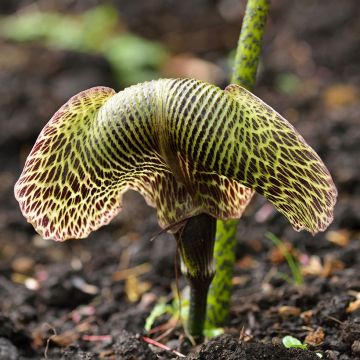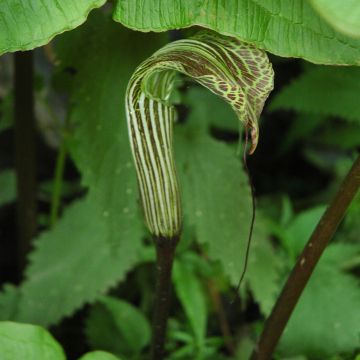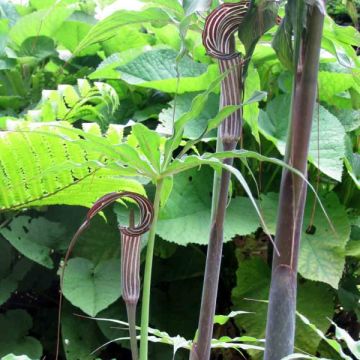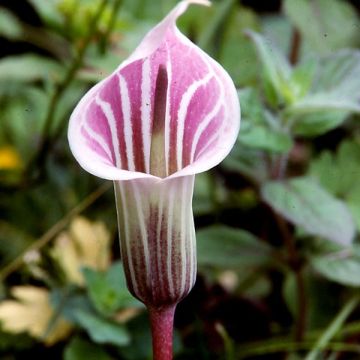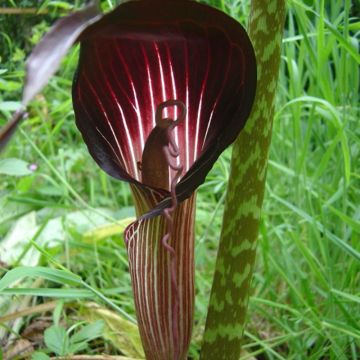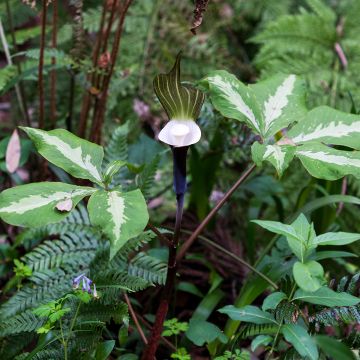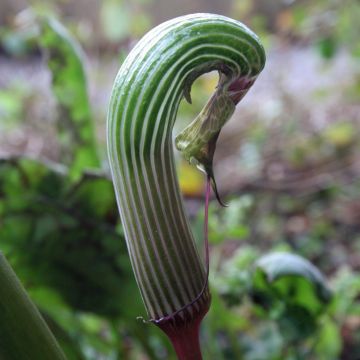
Planting arisaema
Our tips for successfully planting in the ground or in pots
Contents
With its intriguing appearance and spectacular cobra-shaped inflorescences, Arisaema is a plant that never goes unnoticed. Native to Asia, this bulbous perennial, sometimes referred to as “cobra lily” due to the evocative shape of its spathe, adds a touch of exoticism to shaded gardens. Its elegant flowering, often marbled with purple, green, or white, contrasts beautifully with its lush foliage.
Despite its sophisticated appearance, Arisaema is surprisingly easy to cultivate, provided it is given suitable conditions. Whether you wish to incorporate it into a shaded border, a natural woodland, or even in a pot on a terrace, this fascinating plant will bring originality and mystery to your garden. Discover where, when, and how to plant Arisaema, as well as essential tips for maintaining it and watching it thrive year after year!
Where to plant Arisaema?
Arisaema thrives in a woodland atmosphere, alongside ferns, ligularias, and hostas, which share the same moisture and coolness requirements. It particularly enjoys a semi-shaded exposure, ideal for recreating the shaded and humid conditions of its natural habitat. A west-facing orientation is often the most favourable, providing gentle light without excessive direct sunlight.
It prefers soils that remain cool in summer, without being waterlogged, and well-drained in winter to avoid any risk of bulb rot. Arisaema is sensitive to standing water, especially during the cold season.
Plant Arisaema in slightly acidic soil, possibly neutral, but never calcareous. The soil should be rich in organic matter, light, and humus-bearing. In naturally heavy or clayey soil, it is advisable to improve the soil structure to promote good drainage: you can mix 1/3 of potting soil and 1/3 of non-calcareous sand into the planting soil.
Arisaema can also be grown in pots, provided it is placed in the shade, in a well-drained substrate that remains slightly moist.
When to plant Arisaema?
Arisaema is preferably planted in autumn, between September and November, when the soil is still slightly warm, thus promoting rooting before winter. This period allows the plant to settle in well for a vigorous start the following spring.
It is also possible to plant in early spring, from March to April, as soon as the risk of severe frosts has passed. However, growth will be a bit slower in the first year, as the plant will have less time to develop its root system before temperatures rise.
Discover other Arisaemas
View all →Available in 1 sizes
Available in 1 sizes
Available in 1 sizes
Available in 1 sizes
Available in 1 sizes
Available in 1 sizes
Available in 1 sizes
Available in 1 sizes
Available in 1 sizes
Available in 1 sizes
How to plant Arisaema?
In the ground
- Dig a hole about 25 cm deep and wide using a shovel or a spade.
- Loosen the soil well at the bottom of the hole with a rake or a fork to facilitate rooting.
- Add leaf compost and mix it with the soil to enrich the soil. If the soil is heavy (clay), incorporate some coarse sand that is not calcareous to improve drainage. If the soil is calcareous, mix equal parts of heather soil and leaf compost to obtain a slightly acidic substrate.
- Place a layer of perlite or fine gravel about 8 cm deep to prevent water stagnation, a common cause of bulb rot.
- Place the bulb on this draining layer, with the tip facing upwards.
- Cover with soil and lightly firm down.
- Water moderately.
Arisaema is hardy, it can withstand temperatures down to -15 °C, provided the soil remains well-drained in winter. In very cold areas, a thick mulch of fallen leaves effectively protects against frost.
In a pot
- Choose a terracotta pot, wider than it is tall, with a drainage hole.
- Place a layer of gravel or clay balls at the bottom to ensure good drainage.
- Fill the pot with a mixture of half leaf compost and vermiculite or perlite for a light and well-drained substrate.
- Place the bulb about 6 cm deep, tip facing upwards.
- Cover with substrate and lightly firm down.
- Water moderately.
- Position the pot in the shade, in a cool place protected from intense heat.
How to care for Arisaema after planting?
Caring for Arisaema is quite simple, provided you respect its needs in terms of moisture and drainage. After planting, it is essential to keep the soil moist but never waterlogged. Regular watering is necessary during the growth period, in spring and summer, especially during prolonged dry spells. However, care must be taken to ensure that water does not stagnate, as excess moisture is the main enemy of bulbs. In winter, when the plant enters dormancy, watering should be significantly reduced, or even stopped if the soil remains naturally moist.
To maintain soil freshness in summer and protect the bulbs from frost in winter, we recommend installing an organic mulch made from fallen leaves or bark. It limits water evaporation during hot periods and forms an insulating barrier when temperatures drop. In regions with harsh winters, a thicker mulch can be added to enhance protection against the cold.
At the beginning of spring, add some well-decomposed compost or an organic fertiliser rich in organic matter to encourage the resumption of growth. Arisaema does not require intensive fertilisation, but a rich and balanced soil supports its long-term growth.
In autumn, when the foliage turns yellow and dries, allow it to wither naturally. This allows nutrients to return to the bulb, thereby strengthening its reserves for the following season. Once the foliage is completely dried out, you can cut it back to ground level. Finally, regularly monitor the plant for any signs of rot or water stress, and adjust watering or drainage as necessary.
- Subscribe!
- Contents
































